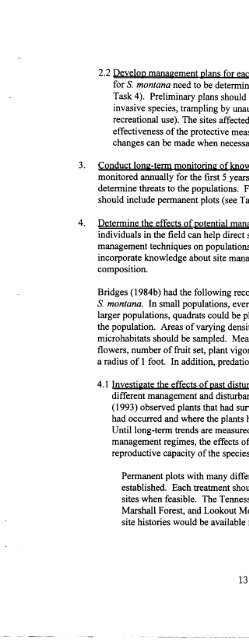Large-flowered Skullcap Recovery Plan - U.S. Fish and Wildlife ...
Large-flowered Skullcap Recovery Plan - U.S. Fish and Wildlife ...
Large-flowered Skullcap Recovery Plan - U.S. Fish and Wildlife ...
Create successful ePaper yourself
Turn your PDF publications into a flip-book with our unique Google optimized e-Paper software.
2.2 Develop management plans for each protected population. Management needs<br />
for S. montana need to be determined before this task can be completed (see<br />
Task 4). Preliminary plans should be developed that deal with threats (e.g.,<br />
invasive species, trampling by unauthorized use, <strong>and</strong> incidental damage through<br />
recreational use). The sites affected by these plans need to monitored so the<br />
effectiveness of the protective measures can be determined, <strong>and</strong> management<br />
changes can be made when necessary.<br />
3. Conduct long-term monitoring ofknown populations. All populations should be<br />
monitored annually for the first 5 years to check the number ofindividuals <strong>and</strong> to<br />
determine threats to the populations. For the larger protected populations, this<br />
should include permanent plots (see Task 4).<br />
4. Determine the effects ofpotential management techniques. Observations by<br />
individuals in the field can help direct studies to document the effects of potential<br />
management techniques on populations ofS. montana. This work should<br />
incorporate knowledge about site management, disturbance history, <strong>and</strong> forest<br />
composition.<br />
Bridges (1984b) had the following recommendation with respect to monitoring<br />
S. montana. In small populations, every plant could be identified <strong>and</strong> followed. In<br />
larger populations, quadrats could be placed r<strong>and</strong>omly or systematically throughout<br />
the population. Areas ofvarying densities, competitive differences, <strong>and</strong><br />
microhabitats should be sampled. Measurements should include height, number of<br />
flowers, number offruit set, plant vigor <strong>and</strong> condition, cover, <strong>and</strong> competition within<br />
a radius of 1 foot. In addition, predation <strong>and</strong> disease should be noted.<br />
4.1 Investigate the effects ofpast disturbances. Long-term trends <strong>and</strong> effects of<br />
different management <strong>and</strong> disturbance regimes need to be studied. Faulkner<br />
(1993) observed plants that had survived in an area where timbering activities<br />
had occurred <strong>and</strong> where the plants had been subjected to low-intensity fires.<br />
Until long-term trends are measured on areas of different disturbance <strong>and</strong><br />
management regimes, the effects ofthese factors on the survival <strong>and</strong><br />
reproductive capacity of the species will not be known.<br />
Permanent plots with many different management histories should be<br />
established. Each treatment should be replicated within a site <strong>and</strong> between<br />
sites when feasible. The Tennessee River Gorge TrustlHicks Gap area,<br />
Marshall Forest, <strong>and</strong> Lookout Mountain seem to be the areas where different<br />
site histories would be available for study.<br />
13

















